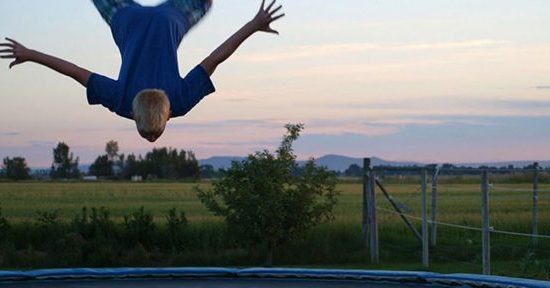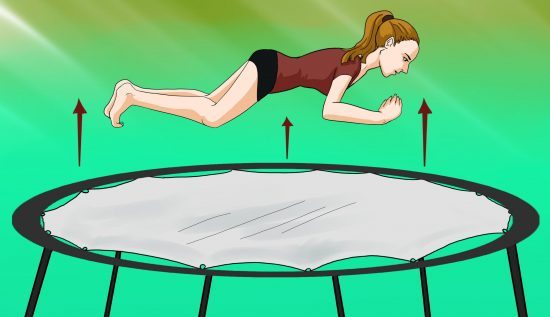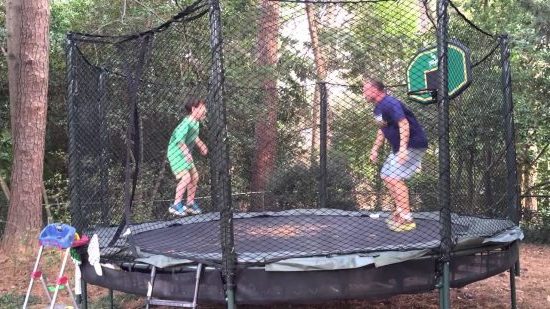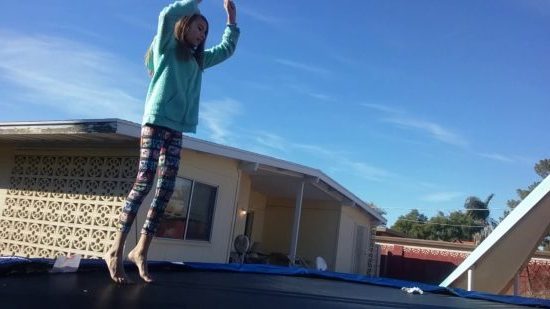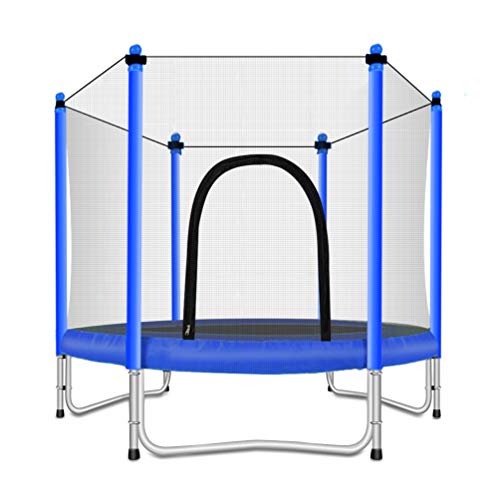Until you can perform a trick without gear, always wear a helmet and elbow pads. You should also have a net around the trampoline and covers around the springs. This will minimize your risk of getting hurt when you fall.
Before you can perform a trick without equipment, be sure to wear a helmet and elbow protection. You should also put a net around the trampoline and cover it around the spring. This will minimize your risk of injury when you fall.
SAFETY NOTICE
Also, never attempt a trampoline trick if you don’t think you can start it correctly. Instead of rushing through, stop jumping and let the trampoline reset to its neutral state before you try again. Eventually, you’ll develop the skills you need to consistently perform tricks – until then, always play it safe.
Similarly, do not attempt to combine tricks until you’ve practiced each of them on their own and know how long they take to perform. For example, you may be able to put a half-spin and a knee drop together, but you may not have the time to do two full spins and still get your legs into the right spot.
Finally, you may want to review these safety tips from Nationwide Insurance, as well as some information about kids doing stunts (if relevant).
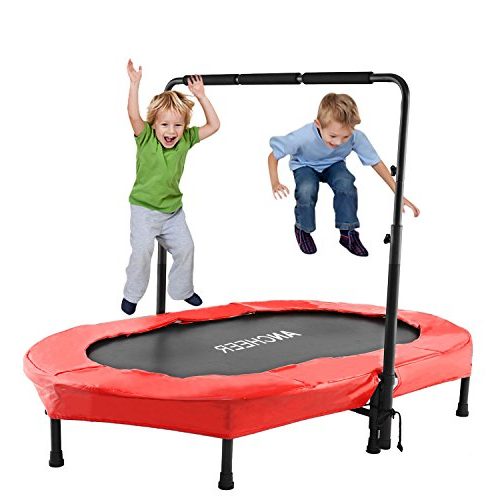
OUR TOP 10 TRAMPOLINE TRICKS
Now that we’ve gone over the safety guidelines let’s take a look at the tricks themselves.
#1: THE SPIN
In this trick, you’ll turn to one side in mid-air before landing on the trampoline again. It sounds simple, but it takes time to master the push needed to spin just the right amount. Start by trying to spin just 90 degrees on each jump, and do this for fifteen or twenty jumps. The goal is to get your body used to the sensation of spinning before you move on to anything more complicated.
Once you’re completely comfortable with the quarter-turn, move up to 180 degrees and keep practicing. Some people make a stop at 270 degrees, but that’s not necessary if you’re comfortable with a half turn. The idea is to work up to a complete revolution in the air. If you’re particularly dedicated, you may go as far as two or three revolutions on each jump.
That said, you should try to finish spinning by the time you start to come down. This gives you a moment to orient yourself before you land. If you’re still twisting when your feet come down, there’s a good chance you’ll fall. Proper spinning is more challenging than it looks, which is why you should take it step by step.
#2: THE SEAT DROP
This trick is all about the landing – literally. After launching into the air, bring your legs up to a horizontal sitting position. This is easier than it sounds thanks to the push from the trampoline. As you do this, your rear will naturally lower and become the point you land on. One of the best parts of this trick is that the first drop usually retains enough force to launch you back up again.
With practice, you can alternate between sitting and standing. Some people even train to do multiple seat drops in a row – and while that’s harder because you don’t have the force of your legs to back things up, it is possible.
The real reason to learn this trick is for safety. If you can switch to a seat drop from an otherwise awkward landing, you can distribute the impact over a wider area of your body and significantly reduce your chance of injury.
For this reason, the seat drop is the first (and sometimes only) trick children should learn.
#3: THE KNEE DROP
This is the same thing as the seat drop, but you’ll be landing on your knees instead of your rear. However, since your legs are actively involved, you can use them in a push to launch yourself back up and land on your feet.
We don’t recommend multiple knee drops – it’s hard to get enough lifting power for multiple jumps.
Like the seat drop, though, this is a pretty good way to distribute force and land safely if you’re not sure you can land normally.
#4: THE DOUBLE BOUNCE
This trick is one of the few that requires a partner. In a double bounce, your goal is to jump at the same time in the center of the trampoline, allowing it to launch you higher than either of you could achieve on your own.
This is one of the more dangerous tricks – if one of you falls, it’s much easier to collide with the other person and fall in a tangle of limbs. For this reason, you should only try a double bounce with someone you’ve already practiced with.
If you don’t have an experienced partner, take it slow and start with small jumps. Get used to match each other’s force and build your way up to a full jump.
Be sure the net is high enough to catch you if you go careening off – some nets aren’t made to protect against the added height of a double bounce.
#5: THE BACK DROP
Hey, it’s a trampoline – dropping is literally half of what you’re doing, so it’s no surprise that so many tricks involve it! The Back Drop is trickier than it sounds, though. The goal here is to fall backward and get pushed back to a standing position by the trampoline. The trick to a successful backdrop is pushing your legs out a bit as you’re falling – this gives the direction and momentum for the trampoline to push back against.
#6: THE FRONT PULLOVER
This is one of the more advanced tricks you can learn. In a front pullover, you want to go well into the air, then roll forward and land on your back. This takes longer to perform than many people realize, and it’s important to have a good launch before you even attempt it.
When done correctly, you should be launched high enough to do a complete vertical spin and land on your back again, allowing you to keep doing from pullovers for as long as you can keep the momentum going.
Make sure to avoid moving too much. You want to be launched up again, not forward. This isn’t the Back Drop.
#7: THE BACK PULLOVER
This is the same as the previous trick, just in the opposite direction. That said, the back pullover is much more difficult than the front pullover is, and you should master its predecessor before you even attempt this.
The real key to success with this trick is getting the right momentum for a spin when you first go back. You may need to bring your legs in (instead of kicking out like the backdrop) to get the right motion.
#8: THE FRONT FLIP
This is the full version of the movement started in the front pullover. Unlike that trick, however, the goal with this one is to land back on your feet… without immediately staggering forward and potentially falling off the trampoline.
That said, the basics of the trick are the same: Launch yourself into the air, then do a full spin and land straight down. If you don’t have any spinning momentum when you land, you can launch back up for another flip.
If you don’t think you can land safely, try to land on your rear instead. It’s always better to distribute the force on a thick part of your body, rather than a fragile joint like the wrist.
#9: THE SIDE FLIP
A companion to the Front Flip, this one is considerably more challenging and should never be practiced without a helmet. As the name implies, the goal of this flip is to twist to your side and land safely back on the trampoline.
To make this easier, some people tuck their legs in and lean to the side as they flip, aiming to land in a knee drop instead of on their feet. Side drops can be slower than the front or back flips, so you should never try to do more than one rotation. This may be the hardest trick of any on this list, so get comfortable with several other tricks (especially the drops, for landing) before you even try this one.
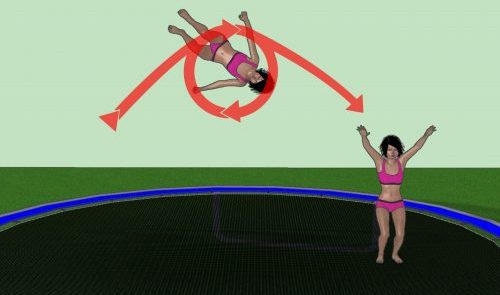
#10: THE BACKFLIP
Finally, last but not least, there’s the backflip. Like the Back Pullover, this is the reverse of its associated front version and takes a little more time to master. Once you have, though, you can move on to more impressive stunts like switching between front and backflips, then going right into a front pullover.
As with all trampoline tricks, it takes practice to do this right – but once you’re a master, you’ll be able to do far more than jump up and down each time you’re on the trampoline.
How to safely do the best trampoline skills
So you want to do some tricks with your trampoline?
It’s a fun way to pass the time, just as long as you do it safely. The truth is that doing tricks and stunts increases the chance of injury. It’s just like soccer or basketball.
Just as you rarely play soccer and basketball in life on a regular basis without getting injured, you run the same risk when doing your best trampoline tricks. And, since 2000, trampolining has actually been a truly Olympic sport. Since 1964, there have even been world championships.
You can see some videos on YouTube for some cool tricks, as well as videos about Olympic trampolining. But you need to calm down and do this safely.
You can’t just twist your body and expect to be successful right away. You’ll probably hurt yourself first! Just like doing anything else, you need to take baby steps.
First Steps
The first thing you need to do is to make sure you actually have a good trampoline to work with. That means it’s fairly new and not 5 years old. It means it was made by a reputable manufacturer. It must have a safety net, and you also need a lot of padding on the frame.
The frame itself should be made of steel. The entire thing must be secured to the ground, and there must be no obstacles ear the jumping area.
Then you should practice by yourself, preferably with someone else standing there by the sideline (and not jumping with you). We’re also going to assume that you’re fairly fit and that you don’t have any health issues that prevent you from doing this.
First Moves
So let’s say you’re a very confident person and you want to start practicing your moves. If you’re already used to jumping up and down with your legs, here are some tricks for beginners:
Tuck
This is the first and most basic move in trampolining and doing tricks. It’s like dribbling in basketball. You can’t do anything else if you can’t do this.
Fortunately, it’s actually very simple. All you need to do is to bring your knees to your chest and grab them with your hands, and then you straighten out before land. That’s it. To be able to do this, you just need to get some height in your jumps so you have enough time in the air.
Keep practicing this move until it becomes second nature for you. The fast tuck is crucial so that you can the rotation necessary for more advanced moves.
Pike Jump
This time, you bring your knees up, but you keep your legs straight in front of you so you form an “L” with your body. Except you don’t really form an L because you also lean forward with your arms straight out in front of you, with your hand in fists.
Straddle Jump
This is like the pike jump with your legs straight, but you spread them in a “V” position so that it seems like you’re going to land on a horse. Again, you hold and stretch your arms straight forward as far as you can go, while you make fists with your hands.
Twists
This time, when you’re high up in the air, you twist your body so that you land facing the opposite direction. That’s a half-twist. A full twist gets you facing in the same direction after you twist.
At first, you’ll make the mistake of twisting from the jumping surface. But you need to do a late twist, meaning you start twisting once you’re in the air, and not as you jump.
Knee drops
This is just like how it sounds. Instead of jumping with your feet, you land and then jump again with your knees.
These are just the basic steps, but they’ll take time to learn. After these, you can try seat drops, doggy drops, front drops and back drops.
More Advanced Tricks
Once you’ve mastered these basic tricks, you can then do them in various sequences.
But for more advanced moves, you really need a proper coach. Check and see if there’s a trampolining class near your location.
Without a coach, the chances of getting hurt are just too high because you don’t have the proper training. It’s like going into battle in Iraq just because you’ve practiced paintball or you’re good in FPS games.
